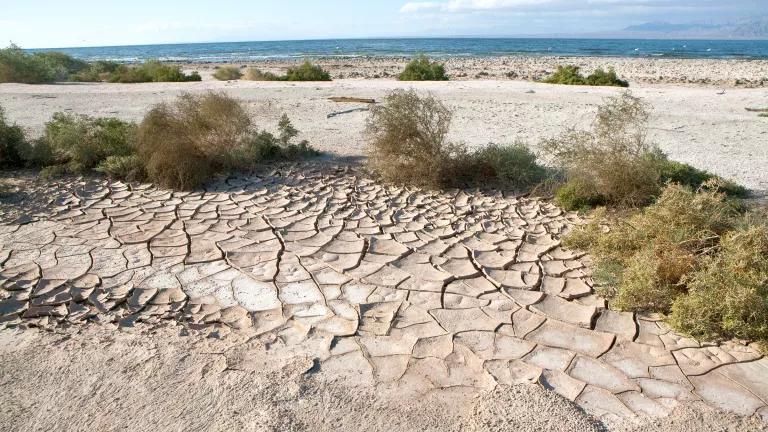How California Will Weather Drought
Researchers outline four key actions the Golden State must take to ensure there's enough water to go around.

The Salton Sea coastline, California
Water use: immense. Water supply: insufficient.
At some point every year, we hear the same old story coming out of California. During the state's recent (and lengthy) periods of drought, the deficit is felt all over. Reservoirs, mountain snowpack, soil moisture, and river levels are hitting near-record lows.
But is the gap between how much water Californians need and how much water is available really unbridgeable?
Not necessarily. Each year, California uses at least six million acre-feet more water than the rivers and aquifers can sustainably provide. (Some perspective here: Just one acre-foot of water equals roughly 326,000 gallons.) But a report by NRDC and the Pacific Institute shows that if the Golden State were to make a few improvements in four key areas, it could save more than twice that. Here’s how:
Step 1: Fix irrigation.
If local agriculture producers used smart irrigation scheduling (meaning they watered crops only when they most need it) and expanded more-efficient drip and sprinkler technology, they would save the state up to 6.6 million acre-feet of water.
Step 2: Be smarter in cities.
Fixing leaky pipes in buildings and under the streets, boosting the efficiency of cooling towers, swapping out water-wasting plumbing fixtures and appliances, and replacing turf grass with native, drought-tolerant plants: This multipronged attack would stop a slow but steady stream of up to 5.2 million acre-feet in wasted water.
Step 3: Recycle more water.
It might seem like an obvious strategy, but Californians aren’t doing enough of it. They could tap up to 1.8 million more acre-feet of recycled water by installing gray water systems to water lawns and flush toilets and by using recycled water to irrigate crops.
Step 4: Capture stormwater.
Up to 630,000 acre-feet of rainwater could be harvested in barrels and cisterns—and then used during dry months. Or these riches from the sky could be directed to open spaces to filter down and recharge groundwater supplies.
This NRDC.org story is available for online republication by news media outlets or nonprofits under these conditions: The writer(s) must be credited with a byline; you must note prominently that the story was originally published by NRDC.org and link to the original; the story cannot be edited (beyond simple things such as grammar); you can’t resell the story in any form or grant republishing rights to other outlets; you can’t republish our material wholesale or automatically—you need to select stories individually; you can’t republish the photos or graphics on our site without specific permission; you should drop us a note to let us know when you’ve used one of our stories.

In Nighttime Shots of Massive Wildfires, a Photographer Shows Us the Light
How to Protect Your Property—and Our Planet—from Harmful Wildfire
Hotter = Drier